Mini E
The Mini E was a demonstration electric car developed by BMW as a conversion of its Mini Cooper car. The Mini E was developed for field trials and deployed in several countries, including the United States, Germany, UK, France, Japan and China.[1] The field testing of the Mini E was part of BMW Project i, which was followed in January 2012 by a similar trial with the BMW ActiveE,[2] and the last phase of project was the development of the BMW i3 urban electric car, that went into mass production in 2013.[3][4] In 2019 BMW announced that the mass market Mini Electric will go in to production.
| Mini E | |
|---|---|
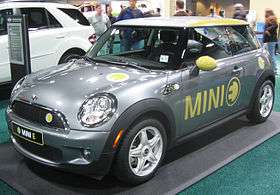 | |
| Overview | |
| Manufacturer | BMW i |
| Production | 2009–2010 |
| Assembly | Oxford, England |
| Body and chassis | |
| Class | Small family car |
| Body style | 3-door hatchback |
| Layout | FF layout |
| Powertrain | |
| Electric motor | 150 kW (200 hp) asynchronous motor |
| Transmission | 1-speed helical |
| Battery | 35 kilowatt-hours (130 MJ) lithium ion battery |
| Range | 100 mi (160 km) |
| Dimensions | |
| Wheelbase | 97.1 in (2,466 mm) |
| Length | 146.2 in (3,713 mm) |
| Width | 66.3 in (1,684 mm) |
| Height | 55.4 in (1,407 mm) |
| Chronology | |
| Successor | BMW ActiveE, Mini Electric |
The first trial was launched in the U.S. in June 2009 and the Mini E was available through leasing to private users in Los Angeles and the New York/New Jersey area.[5] Another field test was launched in the UK in December 2009, where more than forty Mini E cars were handed to private users for two consecutive six-month field trial periods.[6] This trial program allowed the BMW Group to become the world's first major car manufacturer to deploy a fleet of more than 500 all-electric vehicles for private use.[7] After the trial some Mini Es were displayed in museums, others shipped to Germany for further lab testing, and the rest dismantled and crushed.[8] The 40 Mini Es that participated in the UK trial were kept in use after the trial ended in March 2011, participating in promotional activities and forming part of BMW Group UK's official vehicle fleet for the London 2012 Olympic Games.[9]
All Mini E vehicles were equipped similar to a standard Mini Cooper hatchback.
History
The Mini E was unveiled at the 2008 Los Angeles Auto Show.[10] BMW used its Mini brand to test its electric powertrain technology but the vehicle was also developed in order to meet new California regulations that require carmakers to offer zero emission vehicles.[11]
Specifications
Powertrain
The Mini E is powered by an asynchronous electric motor that is mounted in the former engine bay and is rated at 204 PS (150 kW) and 160 lbf⋅ft (220 N⋅m) of torque. Drive is sent to the front wheels. The Mini E employs a lithium-ion battery pack with an overall capacity of 130 megajoules (35 kWh). The batteries weigh 572 pounds (259 kg) and replace the back seat.[12] Top speed is electronically limited to 95 mph (153 km/h), with 0–62 mph (0–100 km/h) acceleration in 8 seconds.[13] The car's range is 156 miles (251 km) on a single charge under optimal conditions. Estimates of normal driving conditions put ranges at 109 miles (175 km) city and 96 miles (154 km) highway.[14]
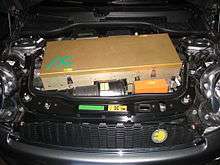
AC Propulsion issued a news release on 19 November 2008, announcing they were a supplier for Mini E.[15] The news release stated that AC Propulsion supplied a specially developed version of its proprietary tzero, a registered trademark, technology, including air-cooled copper-rotor induction motor and Li ion battery on the Mini E. It is characterized by high performance, high efficiency, and fast charging.
Charging
The Mini E could be charged by 120 volt (at 12 amp) and 240 volt (at 32 or 48 amp) power sources; charging times were 20 hours and 3.5 hours (fast-charge system).[16] Charge rate was set from the instrument panel before charging.
The 240 volt 32 amp home "wall box" charging stations for the USA trial were made by Clipper Creek,[17] with a proprietary electrical connector to the car made by ODU.[18]
Performance
The accelerator was a drive-by-wire system with a soft start to limit the electric motor's response and prevent burnout from a standstill. After this initial delay, response goes back to normal.
The Mini E's regenerative braking was designed to capture as much kinetic energy as possible giving it a distinct driving characteristic. When the driver released the acceleration pedal, the Mini E started braking, slowing it down significantly as if the brake pedal were pressed.
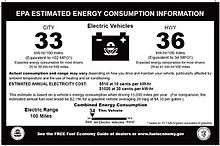
EPA ratings
The United States Environmental Protection Agency (EPA) certified the Mini E range as 100 mi (160 km), with a city/highway combined energy consumption of 34 kW·h/100 miles. Under its five-cycle testing, EPA rated the Mini E at 98 miles per gallon gasoline equivalent (2.4 L/100 km) combined fuel economy, with a rating of 102 mpg‑US (2.3 L/100 km; 122 mpg‑imp) equivalent in city driving and 94 mpg‑US (2.5 L/100 km; 113 mpg‑imp) equivalent on highways. This information was displayed in the window sticker in terms of energy consumption, as 33 kW·h/100 miles for city and 36 kW·h/100 miles for highway.[19]
Production
The Mini factory in Oxford, England supplied vehicle gliders to a team in Munich, Germany who added the electric running gear.[11]
Field trial program
Field testing of the Mini E was part of BMW Project i, and was followed in January 2012 by a similar trial with the BMW ActiveE all-electric vehicle.[2] After the Mini E trial program ended, some cars were displayed in museums, others shipped to Germany for further lab testing, and the rest dismantled and crushed.[8]
Mini E drivers participating in the field trial program of the vehicle were required to participate in online surveys and discussions, and to bring their vehicle into their local dealership to be worked on. The car was available only as a three-year limited lease, and drivers were required to return their cars to BMW who destroyed or donated them to tech schools and museums for display, disassembly, and analysis purposes.
U.S. program
In the U.S. 9,500 people signed up to lease the 450 Mini Es available.[20][21] In June 2009, BMW started the program by leasing 250 units in the Los Angeles area and 200 in the New York/New Jersey area.[3] The leasing price was set at US$850 (approx. €600) a month for one year and included collision coverage, maintenance costs, and home installation of the charging station.[4] Residents of New Jersey did not pay sales tax on their lease due to the existing state exemption for battery electric vehicles.[22]
In May 2010, BMW announced that leasing could be renewed for another year at a lower price of US$600 a month.[23][24] This renewal was offered to all individuals who had a Mini E lease at the time but fleet customers were excluded and according to BMW half of all lessees agreed to the extension.[23][24]
European program
Germany
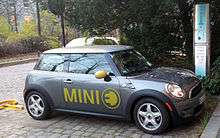
A total of 100 trial vehicles were assigned to Germany.[3] Testing in Berlin began in June 2009, and for the second phase, a total of 70 vehicles were delivered in March 2011 to private customers and fleet users.[27] Field testing began in Munich in September 2010, for a leasing fee of €400 (approx. US$517) per month.[28][29]
United Kingdom
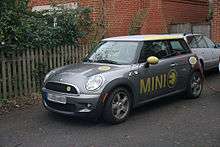
Testing in the U.K. took place between December 2009 and March 2011 with 40 Mini E cars handed to private users for two consecutive six-month field trial periods.[9] The leasing price was set at GB£330 (around US$536) per month, which included VAT, insurance, service and maintenance.[6] One MINI E was delivered to the Government car pool in Downing Street to be tested by ministers in an urban environment on their official business around London.[30]
The UK trial was a partnership between BMW Group UK, Scottish and Southern Energy, the South East England Development Agency (SEEDA), Oxford City Council and Oxfordshire County Council. Data collection and research was conducted by Oxford Brookes University's Sustainable Vehicle Engineering Centre throughout the UK project. Funding support was provided by the Technology Strategy Board and the Department for Transport (DFT) as part of the GB£25 million (US$41 million) UK-wide program involving trials of 340 ultra-low carbon vehicles from several car makers.[6][9][30] The selected test area is roughly a triangle contained within the M40 motorway between the M25 motorway and Oxford, the A34 south to the M3 motorway, and the M3 back to the M25.[31]
The 40 Mini E electric cars were kept in use after the trial was completed in March 2011, participating in activities to promote awareness and understanding of electric vehicles. These cars were part of the BMW Group UK's official vehicle fleet of 4,000 low-emission luxury vehicles deployed for the London 2012 Olympic Games. The fleet also included 160 BMW ActiveE electric cars.[9][32]
China
Field testing in Beijing started on 22 February 2011.[33] Testing also took place in Shenzhen.[9]
Japan
A field trial took place in Tokyo in 2011.[9]
Field test results
The main concerns reported by those participating in the U.S. during the first year trial were range anxiety and lack of public charging infrastructure, as the country had only 734 public charging stations, most located in California.[7][16][34] Another concern was the 100-mile (160 km) range on a fully charged battery reducing to between 80 and 90 miles (140 km) during very cold weather.[7][34] In the UK, an abnormally harsh winter also showed how very low temperatures diminished power output until the battery 'warmed-up'.[25] There was one report of the range dropping below 40 miles (64 km) in sub-zero weather.[35] There were issues reported with exterior charging points as winter temperatures dropped dramatically.[25]
Other complaints in the U.S. related to the lack of space in the car as the battery pack eliminated the Mini's back seat and most of its cargo area,[34][36] and the difficulties found in practice to install the charging equipment in homes; installation permits, site visits, inspections and installation could take up to a month.[36][37]
- BMW
According to the BMW team of engineers responsible for the demonstration program, the following facts and key lessons were learned during the Mini E first year trial:[38]
- Most of the Mini E applicants were well-educated and well-off males over 35, with an affinity for new technology, willing to experience a new and clean technology, and for them the lower vehicle running costs were not very important.
- Most drivers used the Mini E as a second vehicle and for the daily commute.
- Longest trip in a Mini E to date was 158 kilometres (98 mi)
- In the Berlin trial, the average Mini E remained stationary for over five hours in 80 percent of the cases while being charged and most of the customers only charged their vehicles only two or three times a week. U.S. participants were more likely to charge up every night.
- Before the test, drivers said they expected range and charging time limitations to be a problem, however, during the actual trials these issues were only felt to be limitations in very few specific cases.
- In the Berlin test, BMW decided to compare how people drive an electric car to how they drive a more traditional model. For this purpose they identified willing applicants who had either a BMW 116i or a Mini Cooper and put data loggers in those vehicles. The results showed that vehicle usage of the Mini E only differs marginally from that of comparable Mini Cooper and BMW 116i trips.
- UC Davis study
In May 2011 the Plug‐in Hybrid & Electric Vehicle (PH&EV) Research Center at the University of California, Davis published the results of a consumer study of the U.S. Mini E field trial. The study is based on surveys and interviews conducted with more than 120 families who leased the electric car for the period of June 2009 to June 2010.[1][39] Some of the key findings of the consumer study are the following:[1][39][40]
- 95% of the respondents drove fewer than 80 miles (130 km) a day; and 71% drove fewer than 40 miles (64 km).
- The study shows that households adapted their driving around the capabilities of the electric car, and respondents said the MINI E met 90% of their daily driving needs.
- Many drivers found that having limited cargo space and only two seats was more restrictive than the limited range.
- Cold weather had a significant impact on drivers in the New York and New Jersey areas, which suffered a particularly harsh winter during the study period. These drivers discovered an unacceptable drop in the vehicles' range when using the heater.
- In California, though infrequent, hot weather during August 2009 resulted in range loss and battery thermal management problems that required attention from BMW.
- Most drivers reported initial difficulties in mastering the MINI E aggressive regenerative braking system which is integrated into the accelerator pedal. However, all drivers said that once they learned to like the system, they discovered that they could travel more smoothly, and learned to control almost all acceleration and braking events with one pedal. They also discovered, thanks to the display panel information, that they recovered energy proportional to their expertise with the single pedal.
- 99% of respondents found home charging easy to use.
- 71% of respondents said they were more likely now to purchase an electric vehicle than they were a year ago, and only 9% said they are less likely.
- 88% of respondents said they are interested in buying a battery electric vehicle or plug-in hybrid electric vehicle in the next five years.
- Oxford Brookes University
In August 2011 BMW published the results of the UK trials. The findings are based on the 40 test cars driven by 62 members of the public and 76 pool users, who together drove 258,105 miles (415,380 km) over two six-month periods. The data was collected electronically and the research was carried out by Oxford Brookes University. The following are some of the main findings:[9]
- The Mini Es logged a daily journey distance of 29.7 miles (47.8 km), slightly more than the 26.5 miles (42.6 km) recorded by the control cars, a mix of Mini Coopers and BMW 116i models. The UK average daily distance driven for private cars overall is less than 25 miles (40 km).
- The average cost to charge over 6 months was GB£60, representing less than 2 pence per mile.
- Drivers did not charge their Mini E every night. The average was 2.9 times a week. Most charged at home, with 82% using their wall-mounted charging box 90% of the time.
- Four out of five people reported that 80% of their trips could be done exclusively in the Mini E, and this increased to 90% saying that with the addition of rear seats and a bigger boot, all their trips could have been done in the Mini E.
- 84% of the drivers said that the severe low temperatures during both phases of the field trial affected the distance that could be driven between charges, but despite that, four out of five participants told the researchers they thought the Mini E was suitable for winter use.
- When asked for suggestions to deal with the potential danger from the low noise at low speeds, more than half (56%) said that instead of an artificial noise, the driver should pay more attention. However just over a quarter (28%) said they’d like to have a warning noise below 12.5 miles per hour (20.1 km/h).
- The trial found that one week was all that was needed for customers to adapt to the characteristics and peculiarities of driving an EV, such as charging, range, regenerative braking and low noise.
- For fleet users who swapped out of their regular car reported that the Mini E was fine for 70% of journeys made during the working day, while the pool car success rate was even better with between 80–90% of regular trips achievable
Range record
As part of the 21st Century Automotive Challenge held at Penn State University on 23 May 2010, Mini E No. 466 achieved the longest trip in an electric car to date, achieving 147.3 miles (237.1 km). The Mini E went on to win the efficiency competition, traversing three mountain ranges in the rain.
Alternative electric Mini
Nevada's Hybrid Technologies has started production of its electric-powered BMW Mini Cooper all-lithium model. The new electric Mini uses Hybrid Tech's own proprietary advanced lithium management and battery-balancing system. Top speed is only around 80 mph (130 km/h) but driving at a slower speed preserves battery-life and means owners will be able to travel up to 120 miles (190 km) on a single charge.[41]
EVTV has published a free "how-to" series of videos documenting their conversion of a 2009 Mini Cooper Clubman to electric drive.[42] The project uses a more powerful AC induction motor from MES-DEA and TIMS600 controller to provide 177 lb⋅ft (240 N⋅m) of torque. It uses 112 readily available Sky Energy 100Ah LiFePO4 cells to provide an energy storage of 40.3 kWh and a range of 125 miles (201 km). Top speed of 120 mph (190 km/h). This is an open source project using parts readily available to anyone from existing suppliers and intended for those inclined to do their own conversion of an existing 2009 Mini Cooper Clubman.
CravenSpeed, of Portland, Oregon, USA, has built and will offer instructions and parts for converting a 2002–2006 Hatchback Mini into an all-electric vehicle. Utilizing the existing transmission mated to a DC motor, their relatively inexpensive conversion kit will produce modest power and about a 80 km (50 mi) range per charge while keeping the rear seats and cargo room completely untouched.
Motorsport
In April 2010, the Mini E, driven by Thomas Jäger, became the first electric car to lap the Nürburgring Nordschleife in under 10 minutes.[43]
See also
References
- Turrentine, Thomas S., Dahlia Garas, Andy Lentz, Justin Woodjack (2011). "The UC Davis MINI E Consumer Study". Institute of Transportation Studies, University of California, Davis. Archived from the original on 31 May 2011. Retrieved 14 June 2011.CS1 maint: multiple names: authors list (link) Research Report UCD-ITS-RR-11-05
- Jim Motavalli (12 January 2012). "The Mini-E's True Believer Gets the Keys to the First BMW ActiveE". PluginCars. Retrieved 13 January 2012.
- Tom Murphy (19 May 2010). "Mini E Only Beginning of BMW EV Strategy". Wards Auto. Retrieved 13 June 2010.
- Joe Lorio (May 2010). "Green: Rich Steinberg Interview". Automobile Magazine. Retrieved 12 June 2010.
- "BMW and UC Davis Partner on MINI E Study". Green Car Congress. 14 August 2009. Retrieved 25 December 2009.
- "BMW Delivers 40 Electric MINI E Cars for UK Trial". Green Car Congress. 14 December 2009. Retrieved 25 December 2009.
- Peter Whoriskey (24 December 2009). "Recharging and other concerns keep electric cars far from mainstream". Washington Post. Retrieved 25 December 2009.
- Michael Thwaite (10 October 2010). "MINI E Meetup: End of the Line For Electric Car 'Experiment'". Green Car Reports. Retrieved 13 January 2012.
- "BMW Group releases results of UK-supported EV trial". Green Car Congress. 5 August 2011. Retrieved 8 August 2011.
- Abuelsamid, Sam (18 October 2008). "LA Preview: Officially, official: the MINI E!". Autobloggreen.com. Retrieved 30 December 2010.
- Alex Kaufmann. "Technical details for Mini 'E' electric vehicle". MotorAuthority. Archived from the original on 21 December 2008. Retrieved 17 October 2009.
- Taylor III, Alex (30 March 2009). "Bavaria's Next Top Model". Fortune. vol 159 (issue 6): 102.
- Horrell, Paul (November 2008). "Mini Cooper E". Retrieved 11 April 2013.
- "MINI USA: MINI E spec sheet (PDF)" (PDF). Archived from the original (PDF) on 14 July 2011. Retrieved 30 December 2010.
- Press release from AC Propulsion
- John O'Dell (September 2009). "BMW Learning Lessons From Mini E Tes". Edmunds. Archived from the original on 1 February 2010. Retrieved 25 September 2009.
- Richard Steinberg (21 September 2009). "Mini Priority 1 Slides" (PDF). Mini USA. Retrieved 22 June 2010.
- Edgju (25 July 2009). "ODU's connector for MINI E – is this a robust design?". Retrieved 22 June 2010.
- U.S. Environmental Protection Agency and U.S. Department of Energy (17 April 2012). "2008 MINI MiniE". Fueleconomy.gov. Retrieved 19 April 2012.
- Abuelsamid, Sam (6 November 2008). "MINI E will reportedly cost $850/month for one-year lease – Autoblog Green". Autobloggreen.com. Retrieved 17 October 2009.
- "creative projects, competitions, events, thoughts and ideas, by MINI". MINI Space. Retrieved 17 October 2009.
- "State and Federal Incentives for EVs, PHEVs and Charge Stations". Plug in America. Retrieved 29 May 2010.
- "Mini Says Half of Last Year's Mini E Lessees Renewed for Another Year". Edmunds.com. 12 May 2010. Archived from the original on 18 May 2010. Retrieved 12 June 2010.
- "Half of Mini E lessees renew for another year, price dropped to $600/month". AutoblogGreen. 14 May 2010. Retrieved 12 June 2010.
- Chris Wright (3 June 2010). "UK: Harsh winter provides valuable Mini EV feedback". Just Auto. Retrieved 13 June 2010.
- Autoactu.com (24 January 2011). "Marché du véhicule électrique en France en 2010: tous les chiffres!" (in French). Automobile Prope. Archived from the original on 20 September 2011. Retrieved 9 October 2011.
- "BMW Group and Vattenfall Europe begin second phase of MINI E fleet test in Berlin". Green Car Congress. 31 March 2011. Retrieved 10 August 2011.
- "BMW Group Taking Applications for MINI-E Trial Drivers in Munich". Green Car Congress. 10 May 2010. Retrieved 12 June 2010.
- Zaher Karp (May 2010). "Upcoming Munich MIni E Trial". PluginCars.com. Retrieved 12 June 2010.
- "Prime Minister backs MINI E trials". Oxford Brookes University. 16 December 2009. Archived from the original on 12 July 2010. Retrieved 18 June 2010.
- Anthony ffrench-Constant (29 October 2009). "MINI E review: The all-electric version of the MINI is being trialled in Britain". The Daily Telegraph. Retrieved 18 June 2010.
- Antony Ingram (26 March 2012). "BMW's Low-Emissions Olympic Fleet Lands in London". Motor Authority. Retrieved 26 March 2012.
- "Mini E Goes on Field Trial in China". ChinaAutoWeb.com.
- Lawrence Ulrich (25 March 2010). "Gas-Pump Freedom (Restrictions Apply)". New York Times. Retrieved 10 April 2010.
- Jorn Madslien (3 June 2010). "What is it like to live with an electric car?". BBC News. Retrieved 18 June 2010.
- Stephen Williams (19 March 2010). "BMW Preaches Sustainability in Munich and New York". New York Times. Retrieved 10 April 2010.
- Jim Motavalli (16 March 2010). "Home Charging for Electric Vehicle: Costs Will Vary". New York Times. Retrieved 10 April 2010.
- Sebastian Blanco (2 July 2010). "In depth: BMW Megacity Vehicle and Project I". AutoblogGreen. Retrieved 31 July 2010.
- "UC Davis study highlights results of MINI E field trial in US; MINI E met 90% of daily driving needs". Green Car Congress. 13 June 2011. Retrieved 14 June 2011.
- Christine Tierney (14 June 2011). "Quake's effects may delay U.S.-built Leaf". Detroit News. Retrieved 14 June 2011.
- James Martinez. "All-lithium electric Mini Cooper enters production". MotorAuthority. Archived from the original on 22 December 2008. Retrieved 17 October 2009.
- "EVTV.ME Electric car conversion videos". EVTV. Retrieved 5 August 2015.
- Chilton, Chris (14 April 2010). "Mini E Racer (2010) takes on the Nurburgring". CAR Magazine. UK. Retrieved 1 October 2019.
External links
| Wikimedia Commons has media related to Mini E. |